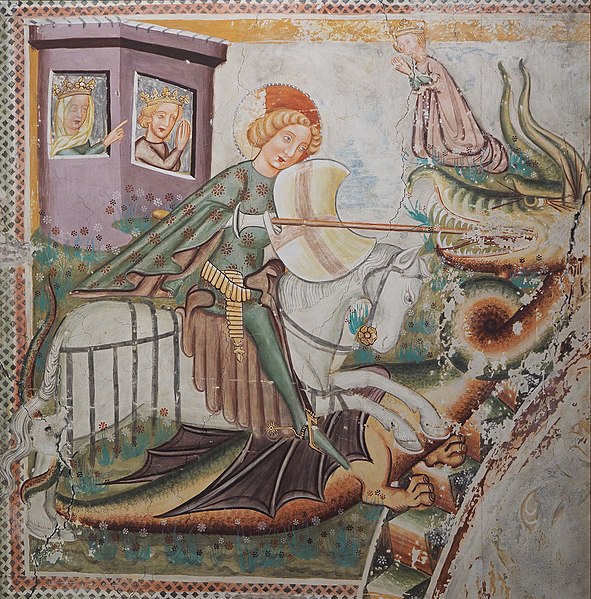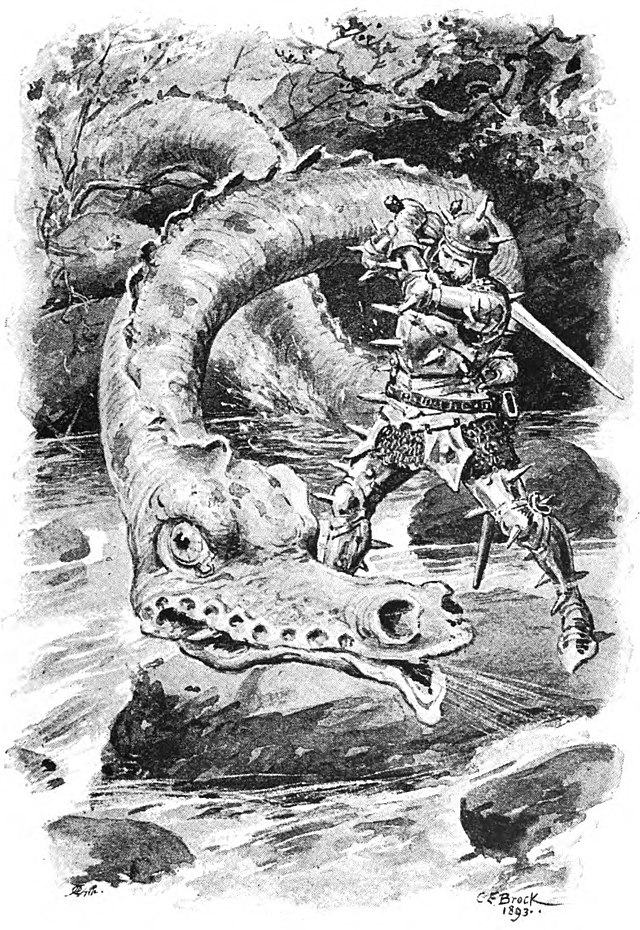 aaa
aaa
Dragons appear in different cultures across the world. Each myth describes a different appearance, though often similar to a lizard or snake. Some myths illustrate dragons as a bit of a nuisance, while others describe terrifying flying creatures that breathe fire. They have become common creatures in popular culture and fascinate people worldwide.
There are many different dragons that appear in English mythology.
A famous sighting of a suspected dragon was in 793. The Anglo-Saxon Chronicle claimed a fire-breathing dragon was spotted flying above Northumbria. It is likely this was actually a comet.
The image of a dragon as a fire-breathing monster with huge wings is common, though most English myths describe dragons differently. They are typically portrayed as crawling creatures that spout poison. They don’t have wings and live in caves or marshes. The Lambton Worm and The Stockburn Worm are two examples of this depiction from Northern England.

English folklore portrays dragons as kidnapping maidens from castles, resulting in a battle with a hero. The hero then slays them and rescues the maiden.
There is a good chance that people living in medieval England believed in dragons. This was obviously before the internet existed, so information spread through written chronicles and word of mouth. People believed that disease spread through poisoned air. Mainly affected were marshes, a habitat for dragons. One story features a dragon that terrorised Dunster in the Somerset levels, before it was banished by St Carantoc.
The dragon was both terrifying and noble to people. Dragons feature on many coats of arms. This image of the dragon was commonly a lizard-like, winged creature, breaking from earlier tradition.
English tradition claims Dragon Hill in South Oxfordshire as the site of the legendary battle between St George and a dragon. The dragon wanted to eat the King’s daughter, so St George bravely fought and killed it. The white spots of chalk on the hill that are still visible today are rumoured to be from the dragon’s toxic blood killing the grass.

It is the medieval depiction of a dragon that appeared in the legend of King Arthur. King Arthur’s father, Uther Pendragon, used the dragon as the royal insignia. The legend also tells of Merlin having a vision of a red dragon fighting a white dragon. He believed the red dragon symbolised Britons and the white dragon symbolised Saxons. Oxford Castle is the birthplace of the legends of King Arthur. The Historia Regum Britanniae (also known as The History of the Kings of Britain) by Geoffrey of Monmouth popularised the story. When written in 1136, it was viewed as an account of history. At the time Geoffrey was serving at Oxford Castle. Its accuracy was first challenged under the Tudors. While it is now considered a work of fiction, Geoffrey claimed it was a translated version of ancient books.
We have the perfect Easter holidays event for any children who love dragons: adopt a dragon sessions!
This event has now finished, however will be back next year. To ensure you don’t miss out, be sure to sign up to our mailing list and be among the first to secure your tickets.


| Cookie | Duration | Description |
|---|---|---|
| cookielawinfo-checkbox-advertisement | 1 year | Set by the GDPR Cookie Consent plugin, this cookie is used to record the user consent for the cookies in the "Advertisement" category . |
| cookielawinfo-checkbox-analytics | 11 months | This cookie is set by GDPR Cookie Consent plugin. The cookie is used to store the user consent for the cookies in the category "Analytics". |
| cookielawinfo-checkbox-functional | 11 months | The cookie is set by GDPR cookie consent to record the user consent for the cookies in the category "Functional". |
| cookielawinfo-checkbox-necessary | 11 months | This cookie is set by GDPR Cookie Consent plugin. The cookies is used to store the user consent for the cookies in the category "Necessary". |
| cookielawinfo-checkbox-others | 11 months | This cookie is set by GDPR Cookie Consent plugin. The cookie is used to store the user consent for the cookies in the category "Other. |
| cookielawinfo-checkbox-performance | 11 months | This cookie is set by GDPR Cookie Consent plugin. The cookie is used to store the user consent for the cookies in the category "Performance". |
| PHPSESSID | session | This cookie is native to PHP applications. The cookie is used to store and identify a users' unique session ID for the purpose of managing user session on the website. The cookie is a session cookies and is deleted when all the browser windows are closed. |
| viewed_cookie_policy | 11 months | The cookie is set by the GDPR Cookie Consent plugin and is used to store whether or not user has consented to the use of cookies. It does not store any personal data. |
| Cookie | Duration | Description |
|---|---|---|
| _ga | 2 years | The _ga cookie, installed by Google Analytics, calculates visitor, session and campaign data and also keeps track of site usage for the site's analytics report. The cookie stores information anonymously and assigns a randomly generated number to recognize unique visitors. |
| _gat_UA-9822230-4 | 1 minute | A variation of the _gat cookie set by Google Analytics and Google Tag Manager to allow website owners to track visitor behaviour and measure site performance. The pattern element in the name contains the unique identity number of the account or website it relates to. |
| _gcl_au | 3 months | Provided by Google Tag Manager to experiment advertisement efficiency of websites using their services. |
| _gid | 1 day | Installed by Google Analytics, _gid cookie stores information on how visitors use a website, while also creating an analytics report of the website's performance. Some of the data that are collected include the number of visitors, their source, and the pages they visit anonymously. |
| CONSENT | 2 years | YouTube sets this cookie via embedded youtube-videos and registers anonymous statistical data. |
| Cookie | Duration | Description |
|---|---|---|
| _fbp | 3 months | This cookie is set by Facebook to display advertisements when either on Facebook or on a digital platform powered by Facebook advertising, after visiting the website. |
| fr | 3 months | Facebook sets this cookie to show relevant advertisements to users by tracking user behaviour across the web, on sites that have Facebook pixel or Facebook social plugin. |
| test_cookie | 15 minutes | The test_cookie is set by doubleclick.net and is used to determine if the user's browser supports cookies. |
| VISITOR_INFO1_LIVE | 5 months 27 days | A cookie set by YouTube to measure bandwidth that determines whether the user gets the new or old player interface. |
| YSC | session | YSC cookie is set by Youtube and is used to track the views of embedded videos on Youtube pages. |
| yt-remote-connected-devices | never | YouTube sets this cookie to store the video preferences of the user using embedded YouTube video. |
| yt-remote-device-id | never | YouTube sets this cookie to store the video preferences of the user using embedded YouTube video. |